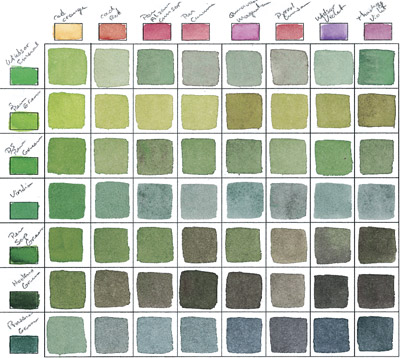Birgit O’Connor’s Color Mixing Chart

Today’s art tip comes from watercolor artist Birgit O’Connor, one of our popular ArtistsNetwork.tv instructors. The following article about using a color mixing chart has great information about the why and how, including a free, downloadable template. Start here, then browse free previews of Birgit’s art video workshops at ArtistsNetwork.tv, where you’ll find more than 500 art workshops to browse!

Color Mixing: The Importance of Using a Color Chart
By Birgit O’Connor
A systematic way to test color combinations before mixing them on your paper is to make a color chart (I’ve provided a link to a template for a blank color-mixing chart here; use it to test your color combinations). By creating color charts, you can teach yourself basic color theory. Better still, when you’re in the midst of a painting and encounter a problem, you can consult a color chart to help you decide what to do.
Imagine that you’re painting the stem of a flower and that, just under the flower, the color shifts. If you’ve got a color chart to consult, you’ll have a good idea how to match that change in color. If you’re painting a landscape, you don’t want the grass to be one, unvaried green because the effect would be flat and uninteresting. You want to create variety in your greens, and consulting your color chart will inform you of choices you may not have thought of on your own: for instance, violet mixed with Hooker’s green or indigo mixed with raw sienna.
To make your color chart, use a half or quarter sheet of watercolor paper so you can post the completed chart in your studio. If you’re working in a cramped space, use 8½x11 sheets and keep them in a folder. Start by making a grid of 1- or ½-inch squares. You’ll want to be able to paint at least 8 to 10 squares of color, with grid lines between them, along the top and down the side of the paper.
Birgit O’Connor, a frequent contributor to Watercolor Artist and The Artist’s Magazine, lives in Bolinas, California. She’s the author of Watercolor In Motion (2008) and Watercolor Essentials (2009), both available at the Artists Network Shop. She has produced a wide variety of instructional videos, available on her website at www.birgitoconnor.com.





yes